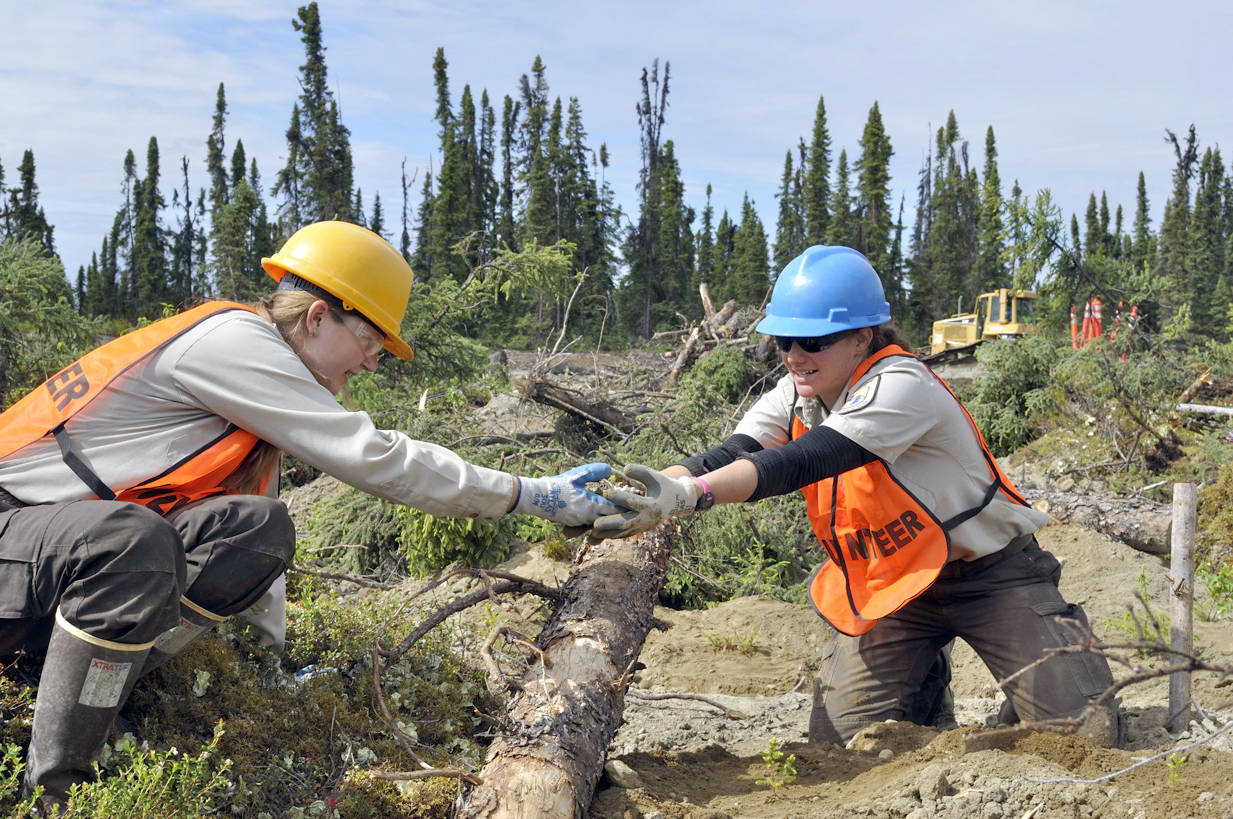By AMBER ROBBINS
What happens to old oil and gas pads when they are no longer useful? This June, I was given the opportunity to find out.
As a biological intern at the Kenai National Wildlife Refuge, I was asked to help restore the Sunrise pad east of the Swanson River Oil Field. This retired pad, originally built by Marathon Oil Corporation in 2008 in hopes of meeting commercial gas needs, was abandoned when production levels didn’t pan out.
A decade later, the Kenai National Wildlife Refuge and Hilcorp Alaska LLC devised a strategy to remedy the problem. Hilcorp hired restoration specialist Lorene Lynn, of Red Mountain Consulting LLC (RMC), to develop a plan and lead the in-field execution with exceptionally well-thought-out details that can only be described as creative restoration.
Three other interns and I were anted up by the refuge as help for the project, to which Lorene eagerly agreed. Our first day on the job we toured the 2.75-acre gravel pad, reviewing the different methods the team planned on using to restore the pad.
The team included Moore’s Landscaping, a local contractor, who over the next few days would transform the flat and compacted gravel pad using heavy machinery to “dimple” the ground, creating a rough and loose ground surface that emulated the complexity of microtopography and microclimates found in nature. I learned that this method is more ideal than tilling as it does not destroy soil cohesion and the outcome more closely resembles a natural landscape.
Together, we transplanted tree seedlings from the surrounding area into the dimpled areas. We chose young spruce trees, avoiding deciduous trees such as willow or birch upon which moose love to snack. This increased the likelihood of a successful restoration by aiming to reduce potential losses from winter moose browsing.
The trees we transplanted were originally surrounded by a mat of vegetation. These vegetation mats are composed of several herbaceous plant species as well as mosses and a complex soil system that will support the health and recovery of the pad.
A Bobcat was used to scoop up these mats so that the root mass remained intact. Unlike many other restoration projects, we did not bring in any outside plants or material — instead, we simply transplanted nearby native vegetation. Not only does this approach save money, but it also reduces the potential of accidentally introducing invasive or other unwanted species as part of the restoration effort.
Something that Lorene reminded the team of throughout the project is that bioengineering is a matter of creating complexity across the landscape. By the end of the project, this ideal was clearly met across the entire pad — the dimpled ground, diversity in vegetation, and boulders and logs left sporadically. We also worked hard to choose young trees that really varied in size, ranging from a couple inches to a couple feet in height.
Although the pad is just a small portion of the area currently leased by Hilcorp for commercial oil and gas extraction, this particular project could provide a solid framework for future restorations. The success of the Sunrise Pad’s restoration will ultimately be judged five years down the road through meticulous measurements of vegetation cover, plant species diversity and tree density.
If it proves to meet the performance standards prescribed in the restoration plan, then these unusually thoughtful methods could be used by others to restore degraded lands to more natural conditions.
I loved being able to see how individual people take extra steps to do a quality job. For example, Lorene recommended reflective Mylar sheeting in response to a suggestion by Hilcorp project manager Kelley Nixon that birds be deterred from nesting in the area before the project got under way.
Together, Lorene and Kelley tied Mylar to the surrounding trees, and removed them once the project started, to promote a “leave no trace” ethic. It is inspiring to be surrounded by people who view their work as more than just a job.
The chance to work on this project is not an experience lost on me. It was an incredible opportunity to see different parties interacting to make a difference.
The refuge, Hilcorp, RMC, Moore’s Landscaping and even we interns helped transform a barren gravel pad into a natural-looking field that is now on a fast trajectory to grow into a native forest. It’s a project I can be proud to have worked on, knowing I’ve planted hundreds of trees that will outlive myself and one day support a complex ecosystem is truly special.
Julie “Amber” Robbins is a biological intern this summer at Kenai National Wildlife Refuge. She will be a senior in Wildlife Ecology and Conservation Sciences at Washington State University this fall. Find more Refuge Notebook articles (1999-present) at https://www.fws.gov/refuge/Kenai/community/refuge_notebook.html.

